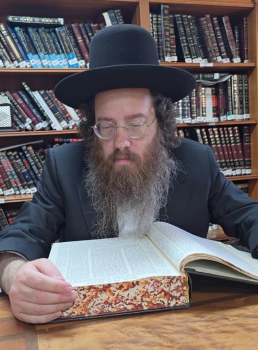Halachic tour of Erets Yisroel
Question
Answer
Thank you for your question.
Of course, perhaps we will call this a halachic tour of Eretz Yisrael, since it is truly amazing that there are no fewer than four seas, mountainous areas, and even a desert, all in this small, holy country, and each one has its own halachic ruling when seeing it for the first time (after 30 days min). We will start with the Mediterranean sea.
The Halachic controversy - The Mediterranean Sea;
The Shulchan Aruch, (Or Hachim, Siman 228.) writes that when one sees the sea or large rivers, one should recite the blessing: ‘Baruch Ata Hashem Elokeinu Melech Ha’olam Oseh (some say: She’oso- past tense) Ma’aseh Bereshis’
The Mishnah Berurah (ibid) writes that the meaning purpose of this blessing is, that when a person sees the creation of Hashem, untouched since the time of creation, this inspires him to relate to Hashem as the creator of the world.
However, the Shulchan Aruch goes on to write, that when one sees the Mediterranean Sea off Eretz Yisrael called the Yam Ha’Tichon then one should recite a special Bracha: “Baruch Ata Hashem Elokeinu Melech Ha’olam she’asah es hayam hagadol ” and the commentary’s ask why this sea is specifically called the Yam Hagadol? Explains the Mishnah Berurah that this special Bracha was initiated to show respect to Eretz Yisrael, That its sea is considered a Yam Hagadol—the great sea."
However, the Mishnah Berurah writes that many halachic authorities disagree and say that the special Bracha (of Sheosoh es Hayam Hagadol) was initiated not for the Mediterranean Sea but rather for the Atlantic Ocean, which is a huge sea. But when one sees the Mediterranean Sea, one should recite the blessing like for all seas : 'Ose Ma'aseh Bereshis’
Lehalcha:
In order to incorporate both opinions, when seeing the Yam HaTichon one should say 'Oseh Ma'aseh Bereshis,' and immediately continue the bracha by saying 'she'asah es Hayam Ha’gadol.
There is only one place on Earth where one can recite 'she'asah es Hayam Ha’gadol' l'chatchilah according to all opinions, and that is when one is in Gibraltar, looking at the Strait of Gibraltar. Here, one is able to see both the Mediterranean Sea and the Atlantic Ocean. Therefore, one can recite 'she'asah es hayam Ha’gadol' according to both opinions, whether it’s for the Mediterranean Sea or the Atlantic Ocean.
I would like to share a story about a person who came to Rabbi Chaim Kanievsky Zt”l and said he was from Gibraltar, to which Rabbi Chaim responded with emotion, 'Wow, Gibraltar is a special place.' When people asked why the Rav said it's so special and how he is interested in that part of the world, Rabbi Chaim explained that when one stands on the Rock of Gibraltar, one is able to see both oceans, the Atlantic and the Mediterranean. So now, according to all opinions, one can recite 'Baruch Ata Hashem Elokeinu Melech Ha’olam she'asah es Hayam Ha’gadol’.
Red Sea off Eilat ;
When one sees the Red Sea off Eilat, then according to all opinions one should recite: 'Ose Ma'aseh Bereshis’ and one doesn’t add ‘she’osoh es Hayam Hagadol’.
Kinneret;
When one sees the Kineret one only has to say “Oseh Ma’aseh Bereshis”
The Dead Sea;
There is a debate among Halachic authorities as to which Bracha to recite. Some argue that since its a sea one should recite 'Oseh Ma'aseh Bereshis.' However, some claim that the origins of this sea are not from the times of creation, as mentioned in Rashi (Genesis 14,3)
בראשית פרק יד, ג
כָּל אֵלֶּה חָבְרוּ אֶל עֵמֶק הַשִּׂדִּים הוּא יָם הַמֶּלַח:
All these (armies) joined together in the Valley of Siddim, which is the Sea of Salt.
רש"י:
הוא ים המלח - לאחר זמן נמשך הים לתוכו ונעשה ים המלח. ומדרש אגדה אומר שנתבקעו הצורים סביבותיו ונמשכו יאורים לתוכו
It is the Salt Sea - After a time, the sea stretched into it and became the Sea of Salt. The Midrash says that the rocks around it split, and rivers started to flow into it.
So, from this explanation, we see that it was not created
during the six days of creation, so it is not appropriate to recite “Oseh Ma'aseh
Bereshis”.
Le’halacha, since the Dead Sea is
located in the Judean desert, one should look at both the desert and the Dead
Sea at the same time and then recite the Bracha of ‘Oseh Ma’ase Bereshis”.
Yarden river;
Since there are opinions that it has changed its flow from the time of creation, Le’halcha we don’t recite “Oseh Ma’aseh Bereshis” when seeing the Jorden River.
Mount Hermon;
When seeing high mountains, the Bracha is “Oseh Ma'aseh Bereshis”. However, if one is used to seeing the Alps of Switzerland, for example, and Mount Hermon does not impress him as a tall mountain, then he is exempt from this Bracha.
Wishing you well and have a safe trip.
Source
Shulchan Aruch, Orach Chaim, Siman 22
Mishnah ibid
Rashi on Genesis 14:3:
